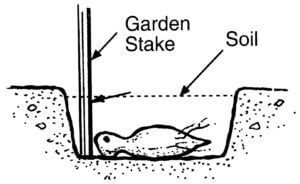Spring
Dahlias are planted in the spring when the ground temperature is approximately 60 degrees or warmer (exceptions will be hot climates); generally, when you would plant your vegetable garden. Planting times vary depending on your exact climate. For example, California, Hawaii, and Florida begin planting in March. The Southern half of the US usually begins planting in the middle of March. Oregon and Washington begin planting at the end of April, while the Northern half of the US begins in May. All areas usually finish planting by the first week of June.
Dahlias need a sunny location to thrive! The more sun, the more blooms. It is recommended that dahlias receive at least 6-8 hours of sunlight per day. Do not plant your dahlias under trees or too close to shrubs, as they will not receive enough sunlight or nutrients to thrive. They can be grown with less sun, but please remember that less sun means fewer blooms and taller plants reaching for the sun. Of all dahlias to consider growing with less sun, the lower-growing and dwarf dahlias will do the best. In hot climates (such as Texas, Arizona, Southern California, many other southern U.S. states, or desert climates), the morning sun with some afternoon shade may be best for proper growth. We recommend not growing bi-color varieties in hot climates, as the white tips can burn. Please remember dahlias require deep water 3 times a week or more by a sprinkler or soaker hose for at least 45–60 minutes during the growing season to bloom properly.
 Dahlias need warm, well-drained soil. Your dahlias will do best when planted in your existing soil if it has not been treated with Preen, Casoron, or other herbicides. If you have a heavier soil, we recommend amending it with peat moss to help lighten it up. Do not amend dahlia beds with purchased topsoil or potting mix unless you are sure it has not been treated for weeds or enhanced with fertilizer. Too rich of soil can burn your dahlia sprouts and cause them not to grow at all. Even if you think you do not have the best soil, this soil may be better than bringing in new soil.
Dahlias need warm, well-drained soil. Your dahlias will do best when planted in your existing soil if it has not been treated with Preen, Casoron, or other herbicides. If you have a heavier soil, we recommend amending it with peat moss to help lighten it up. Do not amend dahlia beds with purchased topsoil or potting mix unless you are sure it has not been treated for weeds or enhanced with fertilizer. Too rich of soil can burn your dahlia sprouts and cause them not to grow at all. Even if you think you do not have the best soil, this soil may be better than bringing in new soil.
To increase the nutrients in your soil, the best all-around soil additive would be cow/steer manure. We use Gardeners Fine Screened Steer Manure in our show garden (Gardeners Fine Screened Steer Manure 2 Cubic Foot - Wilco Farm Stores.) If you add compost to your Dahlia beds, please do so sparingly, as we do not recommend it. Most types of compost are high in Nitrogen, which promotes tall spindly plants, small blooms, fewer blooms, and tubers
that are weak in storage. If you are planting a new dahlia bed, make sure to check all soil, potting soil, and materials being used carefully. The soil must not be sterilized or contain any type of weed killers (herbicides), compost, or fertilizers. If weeds don’t grow in the soil, neither will your dahlias. Although many herbicides (Preen), on the market state they are safe for dahlias, we disagree as we have seen negative results. Hand weeding is the only option when growing dahlias. The pH level of the soil should be 6.5-7.0, slightly acidic. To adjust the pH level in your soil, you may add Lime to increase your pH level or Sulfur to decrease your pH level. Please check with your local garden center or extension office for recommendations for dosage and application.
Here is a local supplier, that has a soil mixture for dahlias that we recommend. Check out their dahlia blend. ( Custom Blends | Highway Fuel in Salem, Or. )
Tuber Size
Dahlias are as unique as people. They come in all shapes and sizes. Tuber size will in no way affect or control the growth or performance of the plants. Some of our largest dahlias produce the smallest tubers, but always produce the biggest healthiest plants and most gigantic blooms. We sell the largest tubers that each variety makes, and we keep the small or broken pieces to plant in our fields. A larger tuber will bloom about 1 week earlier than a small tuber.
However, a smaller tuber will produce more tubers. Please don't judge a tuber by its size. All tubers are guaranteed to grow. Typically, we find that a great blooming season yields less tubers, and a poor blooming season yields more tubers. See the video below.
Tuber Identification
Swan Island Dahlias has a unique way of labeling tubers. You will find the variety name stamped on each individual tuber you receive, as seen in the video. Your tubers will be packaged in the same bag, and you will be able to identify each tuber by the name stamped on it. Some tubers will show sprouted eyes, and others may have dormant eyes when you receive them, as they have not had a chance to warm up in our storage. All tubers are guaranteed to grow.
Single Division Dahlia Tuber Vs. Pot Roots
A single or multi-tuber division (100% of what we offer our customers) is a tuber that has been field grown to maturity, divided, stored, and shipped out to you. A pot root is a dahlia cutting that has been forced in a greenhouse, partially grown, and then dug up and sold. Most dahlias imported from other countries will be pot roots; most domestic U.S. Growers grow and sell dahlias as single divisions. Both will produce and grow beautifully for you; it is just two different growing methods.
Dahlias are ready to go in the ground when your ground temperature has reached 60 degrees or warmer. Be sure that your soil is workable and not soggy. The ground should be warm, well-drained at planting, and in an open sunny location.
If you have heavier soil, add sand, peat moss, or bagged steer or cow manure to lighten and loosen the soil texture for better drainage. Planting dahlias too early, in cold, wet soil, may result in rotting tubers. Dig a hole 4-6” deep, lay the tuber horizontally (on its side), then cover it completely with soil. If the tuber sprout(s) is
longer than 2 or 3" in length, it would be best to trim/pinch the sprout back to a length of 1”. This will not hurt your dahlias, in fact, this will help them have a stronger stalk by pushing through the soil. We recommend planting 12-24" apart. An average 4' dahlia plant will be 18"+ in diameter.
Bone meal is ideal at planting time. Add a small handful of bone meal to the hole and work it in well before planting the tuber. However, beware if you have pets or other animals around; they are attracted to bone meal and may dig up your tubers, so we recommend skipping this step.
This is the ideal time to put in your garden stakes. AT THIS POINT, YOUR DAHLIAS DO NOT NEED MUCH WATER UNLESS YOU ARE GROWING IN CONTAINERS (See container growing instructions). Begin your watering regimen AFTER sprouts have appeared above the ground. There is an EXCEPTION in hot climates and/or container growing, where you will need to be sure the soil is slightly damp at planting as tubers do require a small amount of moisture to get growing. In hot climates, we recommend light watering once a week after planting until the sprout appears. Naturally, we assume Mother Nature will give us enough rain in the northern states at planting time that additional water is not needed until you see the sprouts above ground. However, with changing climates, if your dahlias are planted in bone-dry conditions and you aren’t receiving any rain for a few weeks, you will need to provide your dahlias with a little moisture to get started.

At this point, do not cover your dahlia beds with bark dust or any other mulch, as this will prevent the ground from warming up and allowing your dahlias to get growing. Snail and slug bait should be applied immediately in all climates.
Continue applying slug and snail bait throughout the season to protect them. The average time for dahlias to sprout through the ground is 3-5 weeks. If you have any dahlias purchased from us this season that have failed to sprout through the ground after 5 weeks, dig them up and contact us immediately for assistance. Do not discard them, as photos of them will be required, or return of the tubers may be requested.
We recommend taking any dahlias with a height of 3 feet or more. The best time to stake your dahlias is during the planting process. This will avoid unnecessary damage to the tuber later. Any staking product will work, including tomato cages, metal rods, bamboo stakes, etc. We do offer stakes; please visit our website or farm to view options available.
Many areas receive enough rain to fulfill water requirements for dahlias until the sprouts appear above the ground. Do not water your dahlia tubers after planting unless your ground is dry and no rain is expected in the next few weeks. If, however, you are planting in a hot and dry climate, you will need to water once a week to help the tuber establish its root system until the sprout appears above ground. If you are growing in containers, please see container growing instructions for recommendations.
Start your dahlias no more than 6 weeks before transplanting them outside. Starting your dahlias more than 6 weeks ahead of transplanting will cause weak and spindly plants. Be sure your last frost date has passed, as the tender plant will freeze and die back if moved outside too soon. We recommend starting your dahlia tubers in plain potting soil, peat moss, or a combination of the two.
The tubers should be horizontally planted 3-4" deep and be covered completely. Start and keep them in a warm area above 70 degrees in a location where they will receive at least 8 hours of light once the sprouts emerge. Without proper direct sunlight the plants will be weak and yellow. The planting material should be kept slightly damp and not wet. (Dahlias can rot or develop poorly if the soil conditions are too wet.)
We recommend hardening off (putting them out during the days and bringing them in at night) your dahlias for a week before transplanting them to help them transition. Transplant your dahlias in your beds after the danger of frost is past. The ground temperature should be approximately 60 degrees or warmer. Plants should be about 12" tall or less when you move them outdoors and transplant. If the plants are over 12" high, pinch them back before transplanting. Be sure to plant the tuber 6" deep (this will cover up part of your stalk). After transplanting your dahlias into your beds, they will be stressed and may wilt, be sure to keep them damp and well-watered for at least a week until the roots are established and no longer wilting. Once your dahlias are established, start your summer care regimen.
In general, dahlias do not do as well in pots or containers as they do directly in the ground. If you choose to grow your dahlias in pots or containers, we recommend using the low-growing or dwarf varieties of dahlias, as they are easier to maintain. However, any variety can be grown in a raised bed or container. When choosing a container, ensure there is adequate room for tuber growth. A dahlia could be easily planted in a 15" x 15" pot. For example, you could plant 3 full-size dahlias in a “whiskey barrel” sized pot due to the volume of soil. Raised beds should be a minimum of 12" deep to allow proper growth and drainage.
The planting medium should be 2/3 garden soil/topsoil to 1/3 potting soil or all garden soil. Potting soil alone is too porous, dries out too quickly, and will cause poor growth and blooming results. Be sure that the potting soil and garden soil used are not chemically sterilized or treated with any type of weed killer or herbicide. Avoid potting soil that includes high nitrogen fertilizers, such as Miracle-Gro, compost, etc., as they will burn and rot the tubers.
The difference between growing in containers rather than on the ground is they will need water to start growing. Please make sure to keep your soil slightly damp or cool to the touch after planting, not soaking wet. After planting and until you see the sprouts above the soil level, water sparingly, about once a week. Overwatering to keep the soil wet will result in rotting tubers.
Once the dahlias have sprouted above the soil, water them daily or as often as you would any other container plants. After plants are 12" high, potted dahlias will require extra watering and fertilizing to promote proper growth and blooming. We recommend fertilizing dahlias in containers and raised beds much more often than those planted directly in the ground, as the fertilizer is washed through the soil quicker.
Dahlias need to be watered consistently for proper growth and blooming. In containers, we suggest watering them 1 to 2 times daily once your dahlias are above the ground.
Fertilize approximately every 2–3 weeks with low nitrogen fertilizer or choose a slow-release fertilizer and follow the manufacturer’s recommendations. In raised beds, you will water less often than in a container; however, more often than dahlias planted directly in the ground due to drainage. Fertilizing your dahlias in raised beds is similar to containers, applying it every 2–3 weeks.
Here is a local supplier, that has a soil mixture for dahlias that we recommend. Check out their dahlia blend. Custom Blends | Highway Fuel
Cuttings may be taken in January and February from tubers you grew previously as we are unable to ship until March. Please see our videos for information on how we do cuttings.



